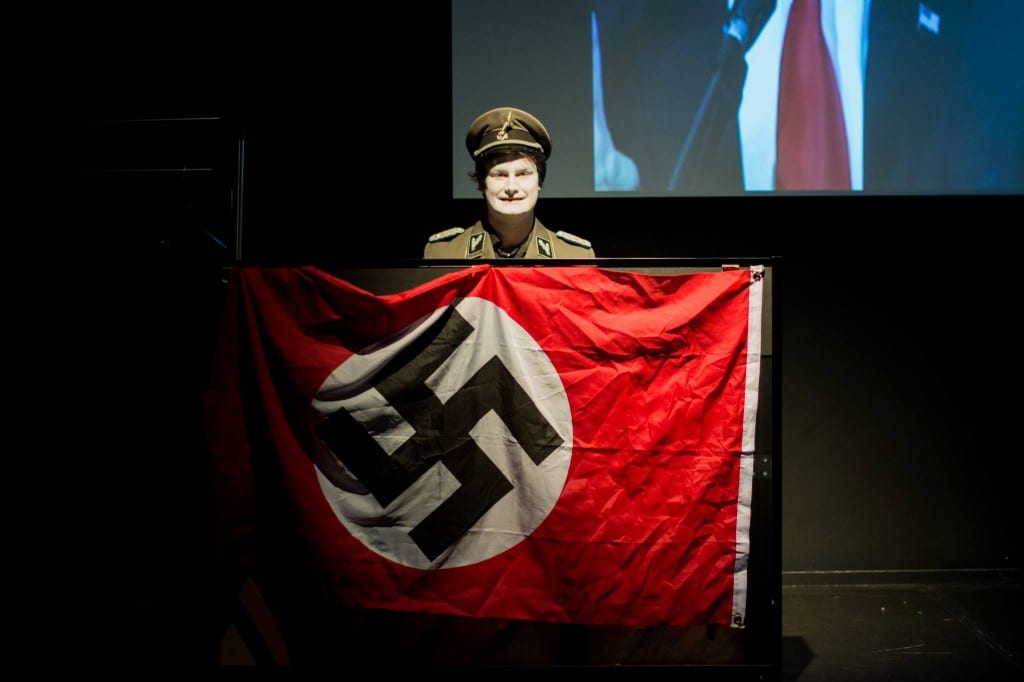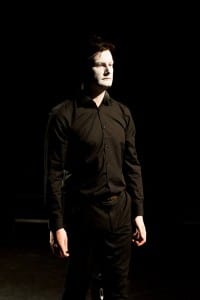Yesterday I performed by debut Solo Performance I Feel Pretty. It was a show that explored vanity, the destruction of materials and objects orchestrated by political leadership. All the elements were in place and overall I thought that the performance went well. In fact, better than expected. The show was incredibly tech heavy and there were a lot of elements that I was concerned about. I was concerned about the execution of the projection-mapping onto my face. I felt that I wouldn’t have been able to meet the mark. Whilst in the performance I missed the mark slightly, causing the projection-mapping to be a fraction off, I felt that seemed more effective than having the projections being completely accurately focused onto my face.
During the final section of the performance I recite one of the final stanzas from W.H. Auden’s 1st September 1939. Before during the tech and the ‘muck-around’ sessions I had planned for the projection-mapping to be completely accurate. Whilst the intention faltered somewhat in the performance the image of half my face being either Savonarola, Goebbels, or Trump and the other as myself, really struck me when watching the performance back.
The new image that I interpreted as accidental was that I still had my voice. My voice and my freedom of expression was seeping out from under the face of political dictatorship.
I felt that my interactions with the shredder could have been more rehearsed. I felt that the nerves got to me as the beginning of the performance progressed. However, despite the shredder being jammed at one point and the nerves slowing the pace of my movements I felt that the image of my ‘destroying’ things was visually noticeable from my audience. On the other hand, what I felt was great about the use of the shredder is the creation of atmosphere and the creation of noise. Even though I had been using the shredder throughout my rehearsal process the noise was something that struck me when I was performing. Even over the recorded voice and Horst-Wessel tracks the noise of the shredder became extremely noticeable and even punctuated and underscored the recorded sound.
Another element that shocked me was the comedy of the piece. Throughout rehearsals I had no intention of making the piece funny or comic. I felt if I pursued to purposefully create comedy in this piece would only cheapen what is happening in the space and the piece overall. My interactions with Jack, an audience member who partook in my performance, became extremely comic for other audience members. My interactions with Jack was inspired by Tim Crouch’s An Oak Tree. I did not think that it would generate comedy. I felt that the comedy and laughter was generated through my tone of voice and how the interactions with Jack fitted amongst the rest of the dialogue. The dialogue in question was this:
The Performer walks up to a microphone. With the bin of the shredder. Takes the microphone and beginning to create the sound of crackling fire.
PERFORMER: Imagine. You are in a crowd. You are in Italy, Florence. It’s 1497. 520 years ago. And there are children and priests destroying mirrors, make-up, fine-dresses, books and paintings by throwing them onto an open bonfire to disrupt the nature of truth. They do it because a man with power and charisma tells them that is the right thing to do, and if they don’t they would be labelled as sinners.
PERFORMER: Hello. Thank you for coming. What’s your name.
The Audience member says their name
PERFORMER: Hello XXXX. Today you are going to become the bonfire. Now take this. And take the flame (passes mic). Make sure to stir the fire gently.
PERFORMER: Imagine. You are in a crowd. You are in Germany, Berlin. It’s 1933. 84 years ago. And the Nazi Student Union are destroying Jewish art. Jewish books. Jewish literature by throwing them onto an open bonfire to disrupt the nature of truth. They do it because a man with power and charisma tells them that is the right thing to do, and if they don’t they would labelled as Jewish Sympathisers.
PERFORMER: You’re doing great XXXX.
PERFORMER: Imagine. You are in a crowd. You are in America, Washington. It’s now. The Republicans are in power. And the Republicans are destroying ‘Fake News’ by distrupting the nature of truth. They do it because a man with power and charisma tells them that is the right thing to do, and if that don’t they would be labelled as Anti-Nationalistic.
PERFORMER: XXXX You can stop now. Place the microphone gently on the floor.
Even though the comedy was unexpected I felt like it enhanced the piece. The dialogue could have ever so easily been regarded as ‘preachy’ and yet the comedy made sure that was not the case. The projections of the Bonfire of the Vanities and the Nazi Book Burnings allowed the speech to be put into context.

The objective of the first words that are spoken in my solo performance: “Imagine. You are in…” directly asks the audience to imagine they are in a place, with the projection contextualising it. The use of such a device provides a similar frame to how Tim Crouch addresses his audience in An Oak Tree. Crouch in the beginning of his piece, tells the audience that they are in a pub a year from now and thereby gives the assumption that neither of them will be involved nor allowed to partake in audience interaction or other elements in the performance. The whole objective of I Feel Pretty was to provide the audience with an experience. I treated the performance more as performance art, rather than theatre. This was due to the simple fact that I was not telling a story. There was no real clear narrative. Just a series of images, sequences and atmospheres.
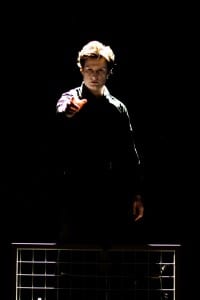
Credit to Ashley Walls ‘Pose One’
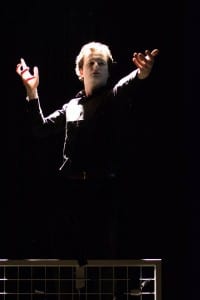
Credit to Ashley Walls. ‘Pose Two’
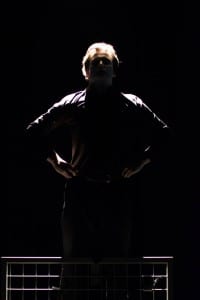
Credit to Ashley Walls.
‘Pose Three’
Whilst the piece initially was inspired by my view on politics I never wanted that to come across in a preach-style way. This intention was something that I felt came across especially in feedback from my audience. Whilst the piece had a lot of physical elements to it and demonstrated effective stage images
FEEDBACK
Overall the feedback from my audience was extremely positive. One of the most frequent positive notes about the show was the use of the microphone inside the bin of the shredder to create the sound of the bonfire. In rehearsals and in experimentation I never expected this element of my performance to receive such a grand response. I was questioned about how I came across using the microphone as a tool to create the audio. Frankly it was just through experimentation. I knew that I didn’t want to cheapen the imagery of a fire sound with the use of a recorded sound effect. I thought that it would seem more theatrical if I created the sound on-stage and it would look more effective. I took influence for this element from Simon Mcburney’s The Encounter. The Encounter was a piece of solo performance that mixed spatial, audio and projection into what I would call an ‘experience.’ Although the show was a form of theatre and told a story, I felt that the main strength of the piece was the creation of an atmospheric experience for the audience. The use of the microphone in my solo performance created the same type of diagetic sound that Mcburney creates when he crumples up crisp packets next to a microphone, thereby creating the illusion of a crackling fire.
In The Encounter Mcburney makes no reference to the fact that the space the audience are in is anything other than the space of a theatre. I attempted to do the same with minimal set, costume and props in I Feel Pretty. Having the projector visible for the projection-mapping also contirubted to this idea. Nothing was really hidden. The Nazi uniform was visible to the audience as was the Nazi Flag. Although the flag was folded it was made to be easily interpreted by the audience. For them to question whether it was actually a Nazi Flag or not. The only thing that was hidden was the Trump mask. This was intentional and it was for shock / surprise effect.
A comment from another audience member which really stood out to me was the effect of the Nazi salute. He said that it was incredibly interesting to see a performance that features a Nazi salute that doesn’t come across as derogatory or offensive.
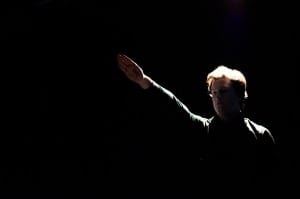
Credit to Ashley Walls ‘Pose Four’
I thought this was a touching and incredibly valuable comment, especially in relation to previous discussions about the simple nature of the physical poses. I had concerns that the Nazi salute might provoke a reactionary response, whether that be an awkward silence or uncomfortable laughter. However, when I was performing those stances I noticed that the audience, whilst being silent, were incredibly attentive. The Nazi salute has so many horrific undertones dating back to Nazi Germany. It has even seen a rise in Neo-Fascism in America as well. For myself to replicate the salute without it being regarded as offensive was incredibly rewarding to hear.
A final comment about the performance was about the treatment of the shredding like confetti. A lot of members of the audience thought that using the paper shreds as confetti and then pouring it onto myself was a startling image. It was also regarded as being ‘beautifully visual.’ In a strange way it felt liberating to throw and pour the paper shredding onto the audience. From the beginning of the performance as the audience entered the space, the shredder was being filled. What was going to happen to the shredding was unknown to the audience. Yet, audience members said that they were wondering what was going to happen with the shredder.
Overall I feel that the piece was successful. It challenged and provoked responses which was my intention and it had accidents which wasn’t foreseen in rehearsals but aided the piece’s effectiveness.






